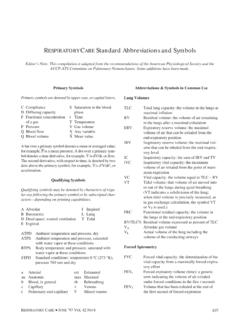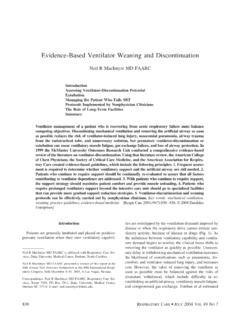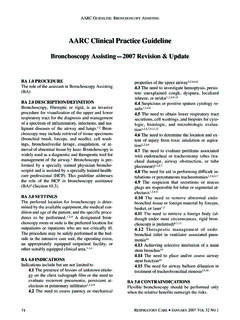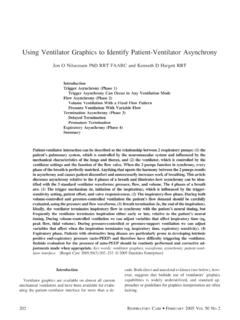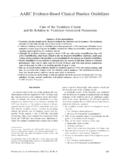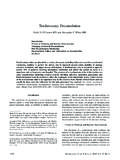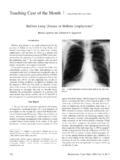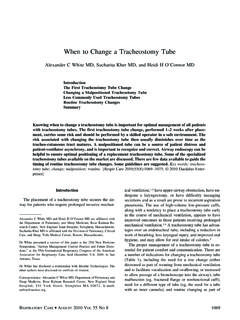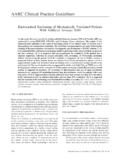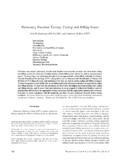Transcription of AARC Clinical Practice Guideline - Respiratory Care
1 AARC Guideline : INTERMITTENT POSITIVE PRESSURE BREATHING. AARC Clinical Practice Guideline Intermittent Positive Pressure Breathing 2003 Revision & Update IPPB PROCEDURE: forms of therapy have been unsuccessful Intermittent positive pressure breathing (incentive spirometry, chest physiothera- py, deep breathing exercises, positive air- IPPB DESCRIPTION/DEFINITION: way pressure) or the patient cannot coop- The first American Association for Respiratory erate13-18. Care (AARC) Clinical Practice Guideline (CPG) for 4 . 1 . 2 Inability to clear secretions ade- Intermittent Positive Pressure Breathing (IPPB) quately because of pathology that severe- was published in 1993.
2 Since that time there have ly limits the ability to ventilate or cough been additional studies, systematic overviews, and effectively and failure to respond to other a meta-analysis that specifically addresses the effi- modes of treatment17. cacy of IPPB as compared to other hyperinflation The need for short-term ventilatory support and aerosol delivery techniques. 1 Those studies for patients who are hypoventilating as an alter- have been added as references to this revised CPG. native to tracheal intubation and continuous IPPB remains a technique used to provide short- mechanical Devices specifical- term or intermittent mechanical ventilation for the ly designed to deliver noninvasive positive purpose of augmenting lung expansion, delivering pressure ventilation (NPPV) should be consid- aerosol medication, or assisting ventilation.
3 2 A ered. caveat, however, is that IPPB is not the therapy of The need to deliver aerosol medication. 4. first choice for delivering aerosol or as a method of (We are not addressing aerosol delivery for pa- lung hyperinflation in spontaneously breathing pa- tients on long-term mechanical ventilation.). tients when other less expensive therapies can reli- Some clinicians oppose the use of ably meet the Clinical objectives prescribed for the IPPB in the treatment of severe bron- p a t i e n t .1 , 3 - 1 2 It should be noted that noninvasive chospasm (acute asthma or status asth- positive pressure ventilation (NPPV) may be con- maticus, and exacerbated COPD); 6 , 2 6 - 2 8.
4 Sidered as a form of IPPB to assist ventilation, al- h o w e v e r, a careful, closely supervised though a review of this therapeutic modality was trial of IPPB as a medication delivery de- not included in this CPG. vice when treatment using other tech- IPPB can include pressure- and time-limit- niques (metered-dose inhaler [MDI] or ed, as well as pressure, time, and flow-cycled nebulizer) has been unsuccessful may be ventilation. ,28-36. IPPB may be delivered to artificial airways IPPB may be used to deliver aerosol and nonintubated patients. medications to patients with fatigue as a result of ventilatory muscle weakness (eg, IPPB SETTINGS: failure to wean from mechanical ventila- IPPB can be administered in settings that include tion, neuromuscular disease, kyphoscolio- hospital, clinic, extended care facility, and home.)
5 Sis, spinal injury) or chronic conditions in which intermittent ventilatory support is IPPB INDICATIONS: indicated (eg, ventilatory support for The need to improve lung expansion home care patients and the more recent The presence of clinically signifi- use of nasal IPPV for Respiratory insuffi- cant pulmonary atelectasis when other ciency).l,19-25,37. 540 Respiratory CARE MAY 2003 VOL 48 NO 5. AARC Guideline : INTERMITTENT POSITIVE PRESSURE BREATHING. In patients with severe hyperinfla- 7 . 3 Only a very small percentage of the tion, IPPB may decrease dyspnea and dis- aerosolized medication optimally deposits in comfort during nebulized the Delivery of a therapeutic medica- tion dose via IPPB may require as much as a IPPB CONTRAINDICATIONS: tenfold increase in medication amount when There are several Clinical situations in which IPPB compared to should not be used.
6 With the exception of untreated 7 . 4 E fficacy of device for ventilation and tension pneumothorax, most of these contraindica- aerosol delivery is technique-dependent (eg, tions are relative:39 coordination, breathing pattern, selection of ap- Tension pneumothorax (untreated) propriate inspiratory flow, peak pressure, inspi- Intracranial pressure (ICP) > 15 mm Hg ratory hold).48-59. Hemodynamic instability Efficacy is dependent on the design of the Recent facial, oral, or skull surgery device (eg, flow, volume, and pressure capabil- Tracheoesophageal fistula ity as well as aerosol output and particle Recent esophageal surgery size).48,50,60-62.
7 Active hemoptysis IPPB is equipment- and labor-intensive as a Nausea method of delivery of ,50,63-67. Air swallowing 7 . 7 Limited portability, lack of instruction, Active untreated tuberculosis and/or lack of 50-psi gas source may affect pa- Radiographic evidence of bleb tient compliance. Singulation (hiccups). IPPB ASSESSMENT OF NEED: IPPB HAZARDS/COMPLICATIONS: Presence of clinically significant atelectasis 6 . 1 Increased airway resistance and work of Reduced pulmonary function as evidenced breathing40,41 by reductions in timed volumes and vital capac- Barotrauma, pneumothorax40 ity (eg, FEV 1 < 65% predicted, FVC < 70%. Nosocomial infection40 predicted, MVV < 50% predicted,68 or VC < 10.)
8 Hypocarbia4,42 mL/kg), precluding an effective cough Hemoptysis4,42 Neuromuscular disorders or kyphoscoliosis Hyperoxia when oxygen is the gas source40 with associated decreases in lung volumes and Gastric distention40 capacities Impaction of secretions (associated with in- Fatigue or muscle weakness with impend- adequately humidified gas mixture)40 ing Respiratory failure Psychological dependence40 Presence of acute severe bronchospasm or Impedance of venous return40 exacerbated COPD that fails to respond to other Exacerbation of hypoxemia therapy Hypoventilation or hyperventilation Based on proven therapeutic effica- Increased mismatch of ventilation and per- cy, variety of medications, and cost-effec- fusion tiveness, the MDI with a spacing device Air trapping, auto-PEEP, overdistended or holding chamber should be the first alveoli method to consider for administration of ,63-67,69,70.
9 IPPB LIMITATIONS OF PROCEDURE OR Regardless of the type of delivery DEVICE: device used (MDI with spacer or small- All of the mechanical effects of IPPB are volume, large-volume, or ultrasonic nebu- short-lived, lasting an hour after lizer), it is important to recognize that the Based on the available literature, MDI or dose of the drug needs to be titrated to compressor-driven nebulizers should be con- give the maximum ,47. sidered the devices of choice for aerosol thera- With demonstrated effectiveness, the pa- py to COPD and stable asthma ,3-8 tient's preference for a positive pressure device Respiratory CARE MAY 2003 VOL 48 NO 5 541. AARC Guideline : INTERMITTENT POSITIVE PRESSURE BREATHING.
10 Should be honored. fective method of delivering IPPB. IPPB may be indicated in patients who are without the need for conventional IPPB. at risk for the development of atelectasis and capital are unable or unwilling to deep breathe without IPPB circuitry includes large bore and connective tubing, nebulizer, adapters, and patient connection (mouthpiece, lip IPPB ASSESSMENT OF OUTCOME: seal, mask, 15-mm ETT connector), and if For lung expansion therapy, a minimum de- needed, nose clips. livered tidal volume of at least 1/3 of the pre- Tissues, emesis basin, or sputum dicted IC (1/3 x 50 mL/kg) has been suggested. cup for collecting or disposing of expecto- This corresponds to approximately 1200 mL in rated sputum a 70 kg adult 1 0.
